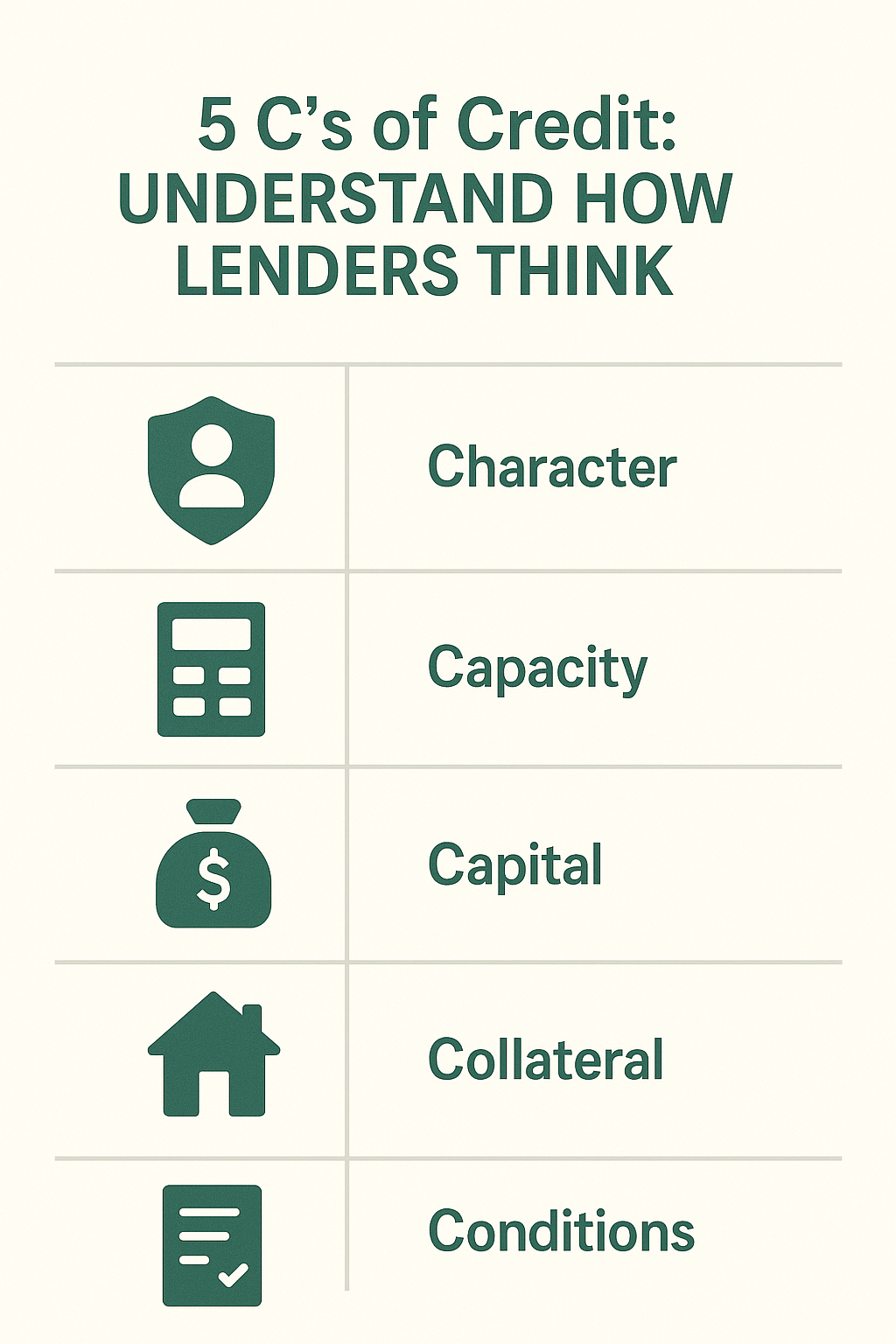When credit assessors first approach a finance application, they typically follow the 5 C’s model to decide if a client is credit-worthy. This process ensures that they have fully considered all the important elements and not omitted any important factors.
These are the client’s character, collateral, capital, capacity, and the conditions of the requested loan.
Character
Character refers to a borrower’s reputation or track record for repaying debts. It’s a view based on the client’s credit file, considering their previous & current lending history and repayment pattern.
Asset Finance
As the loan is secured against the asset, the lender’s character is less important than for working capital. However, the client still needs to demonstrate a robust credit history.
What do Asset Finance Lenders Look for in the Clients Credit File?
- Healthy credit score (minimum scores differ between lenders).
- The age of the client’s history. Longer histories are viewed positively.
- No (or few) recent credit applications for similar loans.
- No payday lending activity (i.e., short-term cash loans).
- No history of adverse activity,e.g., defaults, court judgements, or poor payment history on any recorded financial product.
- How were any previous borrowings conducted? Was the loan paid on time, or was there a history of arrears/missed payments?
- How much had been borrowed previously? If the proposed loan is similar to or less than previous borrowings, this is viewed positively.
- Are any loans active or recently finished? IThis is viewed positively ifthe client has active loans running for over 12 months or recently completed within the last 3-6 months,

Working Capital
Particularly for this type of loan that involves lending cash rather than an asset, the lender doesn’t have a tangible asset to repossess and sell if the loan defaults. The lender also has no control over how the borrower uses the borrowed funds. As such, ‘character’ is given a more substantial weighting for working capital deals.
Given the elevated risk profile of this type of loan, lenders rely on the borrower’s track record of repaying debt to predict future patterns of behaviour. Lenders evaluate the borrower’s ‘character’ by reviewing their credit files, which provide evidence of their repayment history, and look for any adverse findings or low credit scores.
What do Working Capital Lenders Look for in the Clients Credit File?
- Minimum credit score with any lender* = 300
- Preferred credit score* = +600
- Credit file age (the older, the better).
- Recent enquiries have been made through other lenders for working capital.
- Adverse findings or events, including paid or unpaid defaults.
Collateral
When a borrower takes out a loan, they may pledge an owned asset, such as a vehicle or property, as security for the loan. This serves as security for the lender in case the borrower is unable to repay the loan or disappears.
Asset Finance
These types of loans are usually secured by the asset being purchased. Lenders typically don’t secure asset finance loans against the client’s property.
Finance lenders use the loan-to-value ratio (LVR) to assess the risk associated with a loan. LVR differs per lender, but as a guide, the maximum LVR is 130%.
To calculate the LTV ratio, divide the loan amount by the asset’s value. For example, borrowing $80k to buy a car worth $100k means an 80% LVR. Borrowing $120k to purchase and kit out a utility vehicle worth $120k means an LVR of 120%.
The value of an asset is typically determined through an independent appraisal or industry-standard valuation guides. The purchase price of the asset may also be considered. The lender then uses the LVR to determine the risk associated with the loan.
The higher the LVR, the higher the risk for the lender, as the borrower is borrowing a larger percentage of the asset’s value. As such, the lender may charge higher interest rates to offset the increased risk. The lower the LVR, the more positively a lender will consider the application. LVRS can be lowered by offering a deposit or a trade-in.
Working Capital
While assets are not always required for working capital transactions, higher value transactions (over $150k) almost always require property backing at a minimum.
To gain access to these higher transaction amounts, it is essential to discuss the security requirements with the client and ensure they understand their need.
What do Working Capital Lenders Look For?
- Properties or (less commonly) assets mortgaged/owned by the client, as well as the mortgage amount and current market value.
- Mortgage information listed on the credit file, including their repayment history
- Security interests lodged on the Personal Properties Securities Register (PPSR), i.e., an ALLPAP
Capital
Lenders view your access to cash as an indicator of your ability to meet future loan repayments.
What do Lenders Look for?
Lenders consider the client’s property equity, cash position, and leverage with other credit facilities. If the lender seeks access to the client’s bank statements, and they can observe consistent access to liquid funds, this is often viewed positively.
A property-backed client with decent equity, cash in the bank, and no other liabilities will be looked at more favourably than a client with no property, limited cash reserve, and active debts.
A down payment toward the intended use can demonstrate a borrower’s commitment when applying for a loan. Since lenders see this level of commitment, they may be more comfortable extending credit to your client. However, lenders do not always require a down payment as a loan condition.
Capacity
A borrower’s ability to repay a loan is measured by comparing their income against recurring debts to calculate their available funds and debt-to-income ratio. This determines their capacity.
When calculating the upper limit of the client’s borrowing capacity, a general rule of thumb is to double their average verifiable monthly revenue, excluding liabilities. This is determined by looking at the incoming revenue that can be documented in their bank statements. It’s important to note that this method doesn’t factor in recurring business expenses and that revenue isn’t the same as total profit.
To avoid any uncertainties, it’s essential to be clear with your client on how their borrowing capacity is measured and how other liabilities, such as cards, loans, or debt, can reduce their capacity. Remember, the card’s limit is often a deciding factor, not the actual card debt they carry.
Asset finance & low-doc options
Most lenders offer a low-doc or self-declared loan facility, in which the client isn’t required to provide bank statements or proof of income if the client meets specific conditions, e.g, property-backed, deposit provided.
If the client isn’t eligible for a low-doc loan, we need to do a mid-doc or full-doc loan where the client can demonstrate sufficient capacity to service the loan repayment through bank statements or financials.
What do lenders look for?
Generally, lenders will confirm that income is more significant than debits, and they have a healthy cash flow balance.
- Credit cards – credit limit and amount currently owed
- Existing loans – business and asset
- ATO debt – amount and payment plan information (where applicable)
- Turnover – average over 6 months as shown on bank statements
- Upcoming payments or invoices
- Rent cost of premises, assets & plant (monthly)
Conditions
The conditions of a loan, such as the interest rate, loan term, and borrowed amount, are all factors that influence a lender’s decision to finance a borrower.
In addition to these factors, conditions also cover how a borrower intends to use the financing in their business, such as how the funds or assets will boost revenue, and how the lender is positioned in the wider economy, including the business outlook for their chosen industry.
Conditions refer to both the loan agreement terms and external factors that shape lender policy at any given time. Considering these factors carefully is essential to provide your referrer with the most straightforward experience and clear expectations when working with their client.
Business purpose is an important consideration.
Asset finance lenders will seek clarity on how the asset will be used for business purposes (if any), e.g., a car to be used 50% for transport between job sites, or an excavator 100% tasked to fulfil a new work contract.
Working capital lenders will stipulate that their funding will be used exclusively for business purposes, e.g., $50k for an office refurbishment.
What do lenders look for?
Loan Terms
- Document requests
- Security requirements
- Debt/defaults to be paid
- Credit score requirements
- Business purpose
External Factors
These are not necessarily current, just factors influencing lenders’ risk appetite.
- Economy – e.g., increase in RBA rates
- Environment – e.g., bushfires impacted rural businesses = higher risk
- Health Conditions – COVID-19 leadsto high-contact businesses like gyms closing = high risk
- Legislative changes – Lockout laws impacting the hospitality industry = higher risk
- Industry Trends – Milk prices dropping = dairy farmers at higher risk




